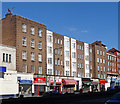1
Brixton Bus Garage, Streatham Hill (A23).
Image: © Noel Foster
Taken: 20 Jul 2005
0.02 miles
2
Telford Avenue
In the Telford Park Estate, which has always been a bit posher than the rest of Streatham. Built up from the 1870s loosely in a Queen Anne style, the houses were designed by E.J. Tarver. Unusually, many are single residences.
Image: © Stephen Richards
Taken: 18 Mar 2020
0.06 miles
3
Telford Court, Streatham Hill
A sizeable block of flats, with shops, designed by Frank Harrington in 1931. The most distinctive features are the four pantiled belvederes with arched openings. It is within the Streatham High Road and Streatham Hill Conservation Area.
The course of Streatham High Road has been a major highway between London and Sussex since Roman times. Its current appearance is largely attributable to two major spells of development. The first was during the late C19th following the opening of Streatham Hill station in 1856, and the second was after 1911 when the line to Victoria was electrified. Though much-maligned and undoubtedly blighted by heavy traffic, closer examination reveals that the road is lined with a number of interesting buildings, some of which reflect the period between the wars when Streatham was a fashionable centre of entertainment. Information from Lambeth Council (http://www.lambeth.gov.uk/NR/exeres/CE4B5CE1-0387-40ED-B5A9-273A5160C34A.htm ).
Image: © Stephen Richards
Taken: Unknown
0.08 miles
4
Telford Avenue Mansions, Telford Avenue
Designed by Frank Verity, Beverley and Homer in c1935. A typical 30s block of flats with metal Crittall windows, and "attractive sunray metalwork" above the front doors. It is within the Streatham High Road and Streatham Hill Conservation Area.
Information from Lambeth Council (http://www.lambeth.gov.uk/NR/exeres/CE4B5CE1-0387-40ED-B5A9-273A5160C34A.htm ).
Image: © Stephen Richards
Taken: Unknown
0.08 miles
5
Telford Avenue, SW2
Image: © Stacey Harris
Taken: 8 Nov 2008
0.08 miles
6
Brixton Bus Garage, Streatham Hill
Image: © Stacey Harris
Taken: 8 Nov 2008
0.08 miles
7
Killieser Avenue
In the Telford Park Estate, which has always been a bit posher than the rest of Streatham. Built up from the 1870s loosely in a Queen Anne style, the houses were designed by E.J. Tarver. Unusually, many are single residences.
Image: © Stephen Richards
Taken: 3 Mar 2020
0.09 miles
8
Telford Parade Mansions, Streatham Hill
Designed, like the neighbouring block, by Verity, Beverley and Homer in c1935. It curves round into Telford Avenue, and has a number of balconies, and shops on the ground floor. It is within the Streatham High Road and Streatham Hill Conservation Area.
The course of Streatham High Road has been a major highway between London and Sussex since Roman times. Its current appearance is largely attributable to two major spells of development. The first was during the late C19th following the opening of Streatham Hill station in 1856, and the second was after 1911 when the line to Victoria was electrified. Though much-maligned and undoubtedly blighted by heavy traffic, closer examination reveals that the road is lined with a number of interesting buildings, some of which reflect the period between the wars when Streatham was a fashionable centre of entertainment. Information from Lambeth Council (http://www.lambeth.gov.uk/NR/exeres/CE4B5CE1-0387-40ED-B5A9-273A5160C34A.htm ).
Image: © Stephen Richards
Taken: Unknown
0.09 miles
9
Wyatt Park Mansions, Streatham Hill
Built, like the neighbouring blocks further up the road, c1935, to the designs of H.J.S. Abrams and Sons. It has white-rendered full-height canted bays, and quoins at the angles. It is within the Streatham High Road and Streatham Hill Conservation Area.
The course of Streatham High Road has been a major highway between London and Sussex since Roman times. Its current appearance is largely attributable to two major spells of development. The first was during the late C19th following the opening of Streatham Hill station in 1856, and the second was after 1911 when the line to Victoria was electrified. Though much-maligned and undoubtedly blighted by heavy traffic, closer examination reveals that the road is lined with a number of interesting buildings, some of which reflect the period between the wars when Streatham was a fashionable centre of entertainment. Information from Lambeth Council (http://www.lambeth.gov.uk/NR/exeres/CE4B5CE1-0387-40ED-B5A9-273A5160C34A.htm ).
Testament to Mr Abrams's construction skills is the fact that the building withstood a direct hit from a flying bomb on 24th June 1944.
Image: © Stephen Richards
Taken: Unknown
0.09 miles
10
Former Streatham Hill Theatre, Streatham Hill
One of the venues which between the wars earned Streatham the sobriquet, "the West End of south London". The theatre, which opened in 1929 with seating for almost 3,000, has a steel frame clad in brick and faced in terracotta, and a giant Ionic loggia above the entrance. The architects were William Sprague (a noted theatre architect) and William Barton. The boards were trodden for the last time in 1962, and it is now used a bingo hall. Grade II listed. The description comments that it is "an unusually lavish example of a theatre built in the short-lived revival of building in 1929-30; as a suburban example of this date the building may be unique." It is within the Streatham High Road and Streatham Hill Conservation Area.
The course of Streatham High Road has been a major highway between London and Sussex since Roman times. Its current appearance is largely attributable to two major spells of development. The first was during the late C19th following the opening of Streatham Hill station in 1856, and the second was after 1911 when the line to Victoria was electrified. Though much-maligned and undoubtedly blighted by heavy traffic, closer examination reveals that the road is lined with a number of interesting buildings, some of which reflect the period between the wars when Streatham was a fashionable centre of entertainment. Information from Lambeth Council (http://www.lambeth.gov.uk/NR/exeres/CE4B5CE1-0387-40ED-B5A9-273A5160C34A.htm ).
Image: © Stephen Richards
Taken: Unknown
0.09 miles











